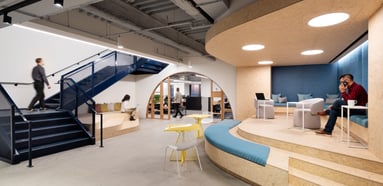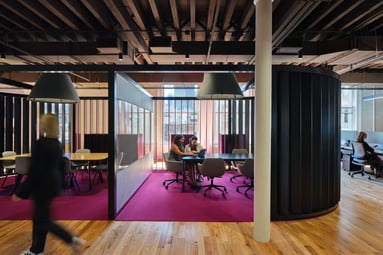More Than the Price Tag: Understanding Value in Interior Design & Build | Insights from Puikheng Lee on the true meaning of value beyond cost in workplace design
.jpg?width=1600&height=933&name=SIN_00082_Site_Safety_Asia_N11%20(1).jpg)
An epiphany struck me while buying lunch today.
As I stood in line, I realized I wouldn’t go to three different places to buy my rice, protein and vegetables just to save a few dollars. I wasn’t just paying for the ingredients but for how the meal was prepared, presented and served a complete experience.
This holds true in corporate interior design and build. A workspace isn’t just the sum of its furniture, flooring or lights. Yet in early budgeting conversations, price is often the first and sometimes only filter. While cost is a crucial factor, focusing solely on the numbers can overlook what truly makes a space functional, inspiring and aligned with your business goals.
Some firms cost more for a reason. Others cost less for a reason. Understanding what’s behind the numbers is where real value becomes visible.
Yes, Materials Are Cheaper But That’s Not the Full Picture
It’s true. Buying your own flooring, partitions, or lighting may appear cheaper than sourcing through a design-and-build firm. On paper, direct procurement can feel like a smart way to cut costs.
But in corporate fit-outs, you’re not just paying for the products. You’re paying for:
- Selections that align with your brand and purpose
- Integration with spatial planning, technology and compliance
- Coordination of delivery, installation and warranties
- Quality assurance and defect rectification
A workplace is a living system and not a collage of items. What a design-and-build partner brings is cohesion, accountability and alignment, not just materials.
 Unispace partnered with suppliers to incorporate sustainable materials into the design of VaynerMedia’s Singapore workplace
Unispace partnered with suppliers to incorporate sustainable materials into the design of VaynerMedia’s Singapore workplace
Why Some Firms Are More Expensive and Others Cheaper
Just like a Michelin-starred meal costs more than takeaway not because the ingredients are drastically different, but because of the execution. Some design firms cost more because they bring more to the table.
A higher-cost firm may offer:
- Experienced designers who merge brand, function and culture
- Seamless coordination across consultants, contractors and vendors
- Schedule confidence, with proactive issue management
- Proven systems for live environment builds or phased delivery
- Higher attention to user experience, ergonomics and long-term adaptability
Conversely, a low-cost quote may reflect:
- Minimal design development or extreme value engineering
- Limited understanding of specialized trades (e.g. M&E, IT)
- Under quoting or missing out important scopes
- Overstretched project teams
- Reduced post-completion support or warranty oversight
In other words: you’re not just paying for what gets delivered, but how well it gets delivered and the risks that are absorbed or passed on to you.
 Unispace combined thoughtful design with purposeful material selection for an international legal firm
Unispace combined thoughtful design with purposeful material selection for an international legal firm
Even a Hard-Boiled Egg Isn’t Just a Hard-Boiled Egg
It sounds simple: just a hard-boiled egg. But anyone who cooks knows there’s a spectrum from runny to fully done and the outcome depends on timing, technique and intention.
Likewise, two offices can look similar in photos, yet feel and function worlds apart. The difference lies in:
- Integration of systems and flexibility for future needs
- Lighting and acoustics
- Circulation and flow
- Detail alignment and joinery execution
Value isn’t always visible in renderings or line items but your team will feel it every day.
Designers and Builders Are Like Chefs. They Add the Magic You Don’t See
Interior designers don’t just pick finishes. Builders don’t just execute drawings. Together, a strong design-and-build team is like a top kitchen brigade:
- Translating intangible goals into real-world spaces
- Anticipating operational challenges and solving them upfront
- Managing trades, budgets and expectations simultaneously
- Creating environments that reflect your identity and support your people
This orchestration is where a large part of the value lies and why experienced firms command higher fees. You’re not paying for decoration; you’re investing in brand experience, productivity and peace of mind.
 Takeda Vietnam partnered with Unispace to localise its global brand through culturally inspired design
Takeda Vietnam partnered with Unispace to localise its global brand through culturally inspired design
Budgeting Should Be Strategic Not Just Reactive
Budgeting isn’t just about saying “no” to things it’s about knowing where to invest.
A corporate interior fit-out is a capital investment. It should support business growth, improve employee experience and enhance your brand image. Choosing a partner who understands how to deliver that without surprises is worth more than the lowest line-item cost.
Final Thoughts: The Real Cost Is in the Outcome
In corporate interiors, the cheapest quote may look appealing at first but could lead to delays, rework or a compromised workplace. The most expensive quote might reflect deep planning, tested processes and a higher-quality end product that lasts longer and performs better.
When it comes to your workspace, you’re not just paying for what's installed. You’re paying for how confidently it’s delivered, how well it functions and how it elevates your business.
Value lives beyond the price tag. They live in the experience, the execution and the impact.
 HSBC Wealth Centre Singapore integrates digital innovation into every client touchpoint
HSBC Wealth Centre Singapore integrates digital innovation into every client touchpoint
Value Evaluation Checklist
Here are some key questions to consider when evaluating design & build proposals. For more insights, reach out to Puikheng Lee.
- Does the team truly understand your business needs, culture, and workflows—and reflect that in the design strategy?
(More than just a visual concept. Is it tailored to how your people use the space?)
- Are senior, experienced team members actively involved throughout the project—or just present during the pitch?
(Ask who will actually manage the day-to-day execution and decision-making.)
- Is the proposal priced too low, potentially leading to variation orders later?
(A lean quote might signal under-scoping and surprise costs mid-project.)
- Is there a clear, realistic timeline—and a track record of meeting deadlines?
(Timely delivery is critical for business continuity, especially in live environments.)
- How are risks, changes, and accountability managed?
(Look for clear processes that prevent blame-shifting and delays.)
About Puikheng Lee, Principal of Delivery at Unispace Southeast Asia

Puikheng Lee is the Principal of Delivery at Unispace Southeast Asia, bringing over a decade of experience in project management and delivery across the region. She joined Unispace in 2019 and has since led the successful execution of complex workplace projects with a strong focus on quality, timelines, and client satisfaction.
Lee holds a Bachelor of Science in Project and Facilities Management from the National University of Singapore.


